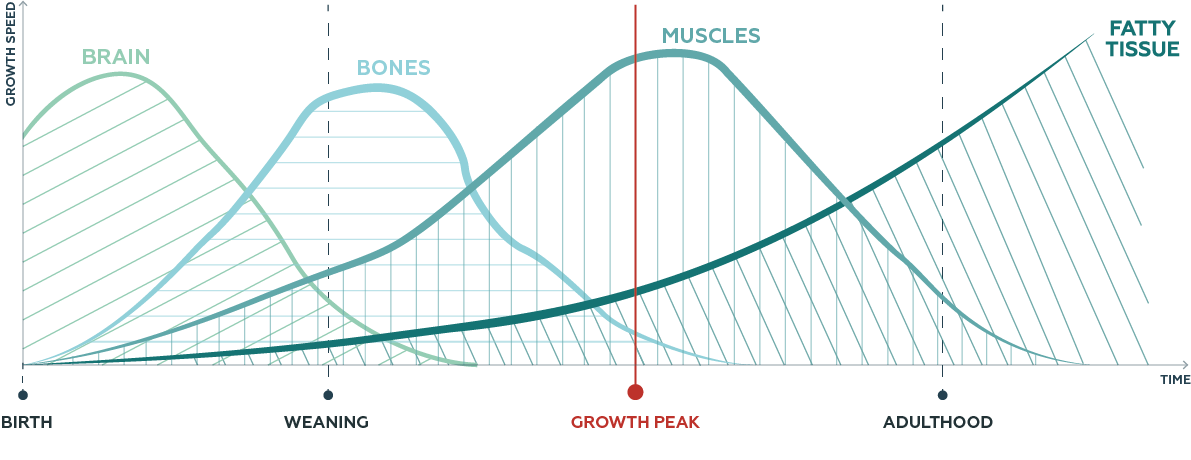
Different profiles and nutritional requirements
Undernutrition is nowadays rare in puppies, but the opposite is unfortunately frequent, which is very detrimental to the puppy's health. The prevention of obesity and orthopedic disorders in puppies requires the control of food intake during growth, coupled with a reasonable lifestyle: physical exercise should not be too violent to protect the still fragile joints.
Growth is assessed by the increase in height at the withers and body weight (BW). These two parameters are genetically determined but the puppy's growth rate is influenced by his energy consumption.
Dog species are unique among domestic animals: from one breed to another, adult weight can vary by a factor of 1 (Chihuahua) to 100 (Mastiff)! These huge disparities obviously lead to very different growth patterns between breeds. The total duration of growth varies a lot: from 8 months in the toy breeds to nearly 24 months for giant breeds. Moreover, a large breed puppy doesn’t have the same growth profile nor the same nutritional requirements as a small breed puppy.
Whatever the breed, two important periods have to be considered, because not all tissues develop at the same rate:
-
The first part of the growth is the most critical because the bones grow the fastest: intense skeleton growth takes place during the first months and particular attention should be paid to feeding and physical exertion during this period, when puppies grow more intensively.
-
The second phase corresponds to muscle development (under the influence of sex hormones), until adult weight is reached. The fat mass (adipose tissue) develops when bones and muscles are already in place. Puppies of large and giant breeds naturally appear poorly muscled before puberty.

 Essentiel pratical advice : It is well established that a dog will have a longer life expectancy and will be better protected from age-related diseases if his growth rate has been well-controlled and his optimal Body Weight maintained over time.
Essentiel pratical advice : It is well established that a dog will have a longer life expectancy and will be better protected from age-related diseases if his growth rate has been well-controlled and his optimal Body Weight maintained over time.You’ll have better chances of preventing overweight if the control is exercised as soon as the puppy is adopted, shortly after weaning. Growth is a key period for establishing good habits.
Weigh your puppy regularly
To control the puppy’s growth rate, it is important to carefully monitor his weight curve, especially during the most rapid growth period. Weighing your puppy every 2 weeks is the best way to control the situation. If a large breed puppy becomes too heavy to be picked up on the scale, don’t hesitate to go and weigh him at a veterinary clinic equipped with a platform scale available to clients.
Keep track of the weight over weeks and months
Each time the puppy’s Body Weight is measured, it will be noted on a growth chart. Veterinarians and breed clubs can provide typical curves for different breeds; these references will help you to evaluate your puppy's growth. Your veterinarian can also help you interpret your puppy's growth curve. For example, if the puppy is gaining weight too fast, your vet can adjust the daily feeding ration or advise a new diet that respects the growth requirements while limiting the caloric intake.
The recorded data are also very useful for the follow-up of the animal: the notion of ideal Body Weight can indeed be refined individually.
It is of course very important to continue this follow-up after sterilization, a critical period when the puppy must receive a 20% reduction in caloric intake to avoid an increase of his fat mass.

In addition to the Body Weight evaluation, you can also assess your puppy's body condition: you just have to observe his silhouette in profile and from above, and to palpate him to evaluate the thickness of the fatty tissue, especially on the ribs. Charts are available at your vet’s clinic to help you.
Measurement of the daily diet
Once defined by the vet or the nurse, it is important to make sure that the quantity of food to be distributed is actually respected on a daily basis. The best way to do this is to weigh the food once and use a measuring cup to determine the volume of the food.
Divide your puppy’s daily ration into three small meals a day until he's at least 6 months old, then 2 are enough.
In a family, it is very important that only one person is responsible for feeding the dog, or that at least everyone is aware of the correct ration to provide and usual feeding times
Beware of the “extras”
In a puppy, excess weight is favored by several factors added together: excessive daily ration compared to the real energy needs, insufficient physical activity, distribution of leftover meals in addition to the normal food, children who share their snacks with the puppy, competition with another animal in the house (the puppy regularly finishes the cat's bowl for example), etc.
If you wish to give treats to your puppy, preferably use kibbles removed from the ration (reducing the daily ration accordingly), or low-caloric treats.
Anyone who wants to please/reward the dog will be encouraged to play or go for a walk with him rather than feed him. He will appreciate this kind of attention as much or more.
|
It has been proven that puppies who maintain an optimal Body Weight (by controlling their energy consumption according to their changing body condition) are healthier and gain two years of life expectancy compared to puppies fed ad libitum. Throughout development, nutrition must be adapted to the puppy's growth curve. Regular monitoring, combined with an assessment of the body condition score, will make it possible to individualize the rationing and will contribute to promoting harmonious growth. |
